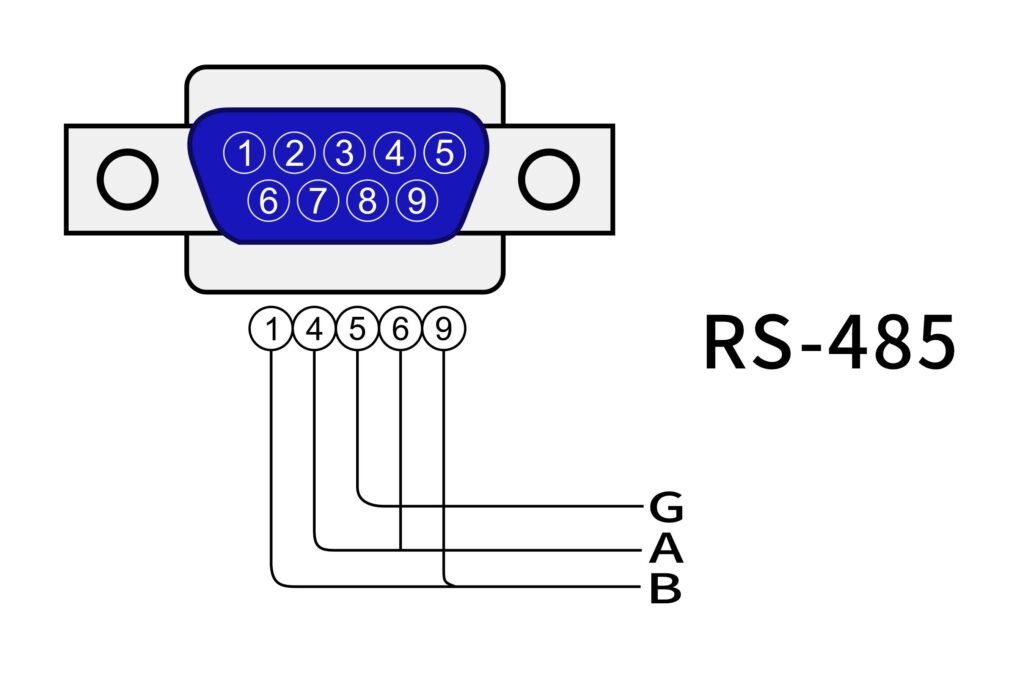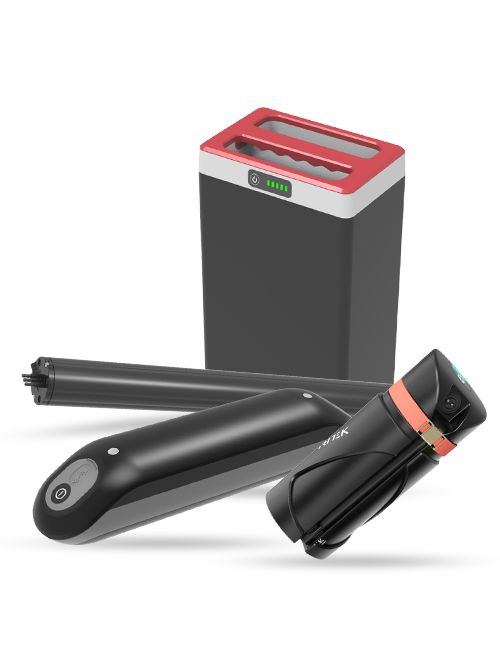One essential component that facilitates communication and data transfer within lithium-ion battery systems is the RS485 protocol. Efficiently managing and monitoring lithium-ion batteries is crucial for optimizing their performance, ensuring safety, and extending their lifespan.
In this article, we will explore the concept of RS485 in lithium batteries, its advantages, applications, and the importance of its integration.
What is RS485 in Lithium Batteries?

RS485, also known as TIA/EIA-485, is a serial communication protocol widely used in various industrial applications, including data acquisition systems, process control, and automation.
It is a balanced differential bus standard, meaning it uses two wires for communication: one for transmitting data (TX) and the other for receiving data (RX).
Unlike RS232, RS485 supports multiple devices on the same bus, making it ideal for applications where multiple components need to communicate over a long distance.
RS485 is employed in lithium battery systems to establish reliable communication between the battery management system (BMS) and individual battery cells or modules.
The BMS is responsible for monitoring and controlling the state of charge (SOC), state of health (SOH), cell balancing, and other critical parameters of each battery cell.
Using RS485, the BMS can communicate with multiple battery cells in a daisy-chain configuration. Each battery cell has its RS485 transceiver that facilitates bidirectional communication with neighboring cells and the BMS.
This enables real-time data transmission and ensures that the BMS can accurately monitor and manage the entire battery pack.
Why Do You Need RS485 in Lithium Batteries?
Integrating RS485 into lithium battery systems offers several critical advantages:
1. Enhanced Safety: The real-time communication enabled by RS485 allows the BMS to detect and respond to any abnormalities or faults in the battery cells promptly, preventing potential safety hazards.
2. Optimal Battery Performance: RS485 enables the BMS to balance individual battery cells’ charge and discharge, ensuring uniform performance and prolonging the overall battery life.
3. Efficient Battery Monitoring: With RS485, the BMS can continuously monitor key parameters of each battery cell, allowing early detection of degradation or malfunction.
4. Smart Battery Management: RS485 facilitates intelligent battery management, enabling features like cell balancing, capacity estimation, and predictive maintenance.
Fascinating Advantages
- Robust and Reliable Communication: RS485 is known for its robustness and noise immunity.
Its differential signaling method allows it to effectively resist electromagnetic interference, making it reliable in harsh industrial environments or electrically noisy settings. - Long Communication Distance: RS485 supports long-distance communication, making it suitable for applications where the battery cells or modules are physically dispersed.
It can cover distances of up to 1,200 meters (4,000 feet) without requiring signal boosters or repeaters. - Multi-Device Communication: RS485 allows multiple devices to be connected to the same bus, enabling efficient communication between the battery management system (BMS) and individual battery cells or modules.
This simplifies the wiring and reduces the number of communication lines required. - Cost-Effectiveness: RS485 offers a cost-effective solution for communication in lithium battery systems.
The transceivers are relatively affordable, and the reduced wiring complexity leads to cost savings in the overall system design. - Low Power Consumption: RS485 transceivers consume low power, making them suitable for battery-powered applications like electric vehicles.
The low power consumption contributes to energy efficiency and extends battery life. - Standardized Protocol: RS485 follows a standardized communication protocol, which ensures interoperability between devices from different manufacturers. This allows for flexibility in choosing components and integrating them into the battery system.
- Easy Integration: RS485 is widely used in industrial applications, and many microcontrollers and communication chips come with built-in RS485 support, simplifying integration into lithium battery systems.
- Real-Time Communication: RS485 facilitates real-time data transmission between the BMS and battery cells, enabling rapid monitoring and response to critical parameters such as state of charge (SOC) and state of health (SOH).
- Simple Topology: RS485 communication uses a simple bus topology, where devices are connected in a daisy-chain fashion. This straightforward configuration allows for easy expansion of the system with additional battery cells or modules.
- Industry Proven: RS485 has been extensively used in various industrial applications for decades and has proven its reliability and effectiveness in real-world scenarios. This track record makes it a trusted and well-established communication standard.
- Minimal Latency: RS485 communication introduces minimal latency in data transmission, which is crucial for applications requiring quick response times, such as in electric vehicles or battery backup systems.
- Scalability: While RS485 has its limitations in terms of the number of devices on the bus, it is still scalable within its operational range. For medium-sized battery systems, RS485 offers an excellent balance between scalability and cost-effectiveness.
Overall, RS485 provides a reliable and efficient communication solution for lithium battery systems.
Its advantages in long-distance communication, multi-device support, and cost-effectiveness make it a preferred choice for many applications in electric vehicles, renewable energy storage, and industrial battery systems.
Unpleasant Disadvantages
- Limited Data Transfer Speed: RS485, while reliable, may have limited data transfer speed compared to some other communication protocols.
This limitation could become a concern in applications where real-time data analysis and quick responses are crucial. - Complexity in Configuration: RS485 communication requires careful configuration and addressing of devices on the bus.
Setting up the network and ensuring proper termination can be time-consuming and may require expertise, making the initial setup more complex. - Susceptibility to Noise: Although RS485 is designed to be noise-resistant, it is not entirely immune to external interference.
In harsh industrial environments or applications where electrical noise is present, RS485 signals may be affected, leading to communication errors or disruptions. - Limited Number of Devices: RS485 supports multiple devices on the same bus, but there is a practical limit to the number of devices that can be connected.
As the number of devices increases, the bus load also increases, potentially affecting the overall communication performance. - Lack of Built-in Redundancy: RS485 does not inherently offer built-in redundancy or fault tolerance.
If a single communication line or device malfunctions, it can disrupt the entire communication on the bus, potentially leading to data loss or miscommunication. - Wiring Complexity for Long Distances: While RS485 can support long communication distances, the wiring complexity increases with distance.
For extended distances, the need for proper grounding, shielding, and consideration of cable impedance can become more critical, adding to the overall system complexity. - Compatibility Challenges: Different manufacturers may implement RS485 communication with variations in voltage levels or signal timings.
Ensuring compatibility between devices from different vendors might require additional effort and compatibility testing. - Limited Scalability: As the communication demands of a lithium battery system grow, RS485’s scalability might become a concern.
In larger battery packs or complex systems, alternative communication protocols like CAN Bus or Ethernet might offer better scalability options. - Power Consumption: While RS485 transceivers generally have low power consumption, in battery-powered applications, even modest power requirements can contribute to overall energy consumption, impacting the battery’s operating life.
- Dependency on Master-Slave Topology: RS485 typically relies on a master-slave topology, where a central BMS acts as the master and communicates with individual battery cells as slaves.
This dependency may pose limitations in certain applications that require more peer-to-peer or decentralized communication structures.
Despite these disadvantages, RS485 remains a widely adopted communication protocol in lithium battery systems due to its reliability, cost-effectiveness, and suitability for certain applications.
Manufacturers and designers need to carefully consider their specific requirements and constraints when choosing the most appropriate communication protocol for their lithium battery systems.
RS485 vs. Other Communication Types
When it comes to communication protocols for data transfer and control in various applications, RS485 competes with several other communication types.
Each communication type has its strengths and weaknesses, making them suitable for specific scenarios. Let’s compare RS485 with some other commonly used communication types.
RS485 vs RS232
| Communication Type | RS485 | RS232 |
|---|---|---|
| Communication Standard | Balanced differential bus standard | Single-ended communication standard |
| Communication Distance | Up to 1,200 meters (4,000 feet) | Up to 15 meters (50 feet) |
| Noise Immunity | Highly immune to electromagnetic interference, suitable for noisy industrial environments | More susceptible to electromagnetic interference, less suitable for noisy environments |
| Multi-Device Communication | Supports multi-point communication, allows multiple devices to be connected to the same bus | Typically limited to point-to-point communication between a single transmitter and receiver |
| Data Transfer Speed | Moderate data transfer speed, sufficient for many industrial applications | Lower data transfer speed compared to RS485, limiting its application in longer-distance communication |
| Configuration | Requires careful termination and addressing of devices on the bus | Generally simpler to set up as it usually involves a single transmitter and receiver |
| Cost | Relatively cost-effective, especially for applications with multiple devices and long communication distances | Lower cost due to its simple configuration and lower data transfer speed |
RS485 vs CAN Bus
| Communication Type | RS485 | CAN Bus |
|---|---|---|
| Communication Standard | Balanced differential bus standard | Controller Area Network (CAN) |
| Communication Distance | Up to 1,200 meters (4,000 feet) | Up to 1,000 meters (3,280 feet) |
| Noise Immunity | Highly immune to electromagnetic interference, suitable for noisy industrial environments | Highly immune to electromagnetic interference, suitable for automotive and industrial applications |
| Multi-Device Communication | Supports multi-point communication, allows multiple devices to be connected to the same bus | Supports multi-point communication, allows multiple devices (nodes) on the same bus |
| Data Transfer Speed | Moderate data transfer speed, up to 10 Mbps (Higher speeds possible with RS485 USB converters) | High data transfer speed, up to 1 Mbps (Higher speeds possible with CAN FD) |
| Topology | Bus topology, devices are connected in a daisy-chain fashion | Bus topology, devices are connected in parallel with a termination resistor at each end |
| Error Handling | Basic error detection with checksums for improved error checking | Advanced error detection and handling with automatic retransmission of corrupted frames |
| Real-Time Capability | Limited real-time capabilities, suitable for non-time-critical applications | Designed for real-time applications, commonly used in time-critical systems like automotive control |
| Cost | Relatively cost-effective for medium-range communication | Moderately higher cost due to advanced features and real-time |
Interested in this communication? Then discover more information about CAN Bus.
RS485 vs Ethernet
| Communication Type | RS485 | Ethernet |
|---|---|---|
| Communication Standard | Balanced differential bus standard | Wired networking standard |
| Communication Distance | Up to 1,200 meters (4,000 feet) | Up to 100 meters (328 feet) with Ethernet cable |
| Noise Immunity | Highly immune to electromagnetic interference, suitable for noisy industrial environments | Susceptible to electromagnetic interference, may require shielding in noisy environments |
| Multi-Device Communication | Supports multi-point communication, allows multiple devices to be connected to the same bus | Supports multi-point communication through network switches and routers |
| Data Transfer Speed | Moderate data transfer speed, sufficient for many industrial applications | High data transfer speed, up to 10 Gbps (Gigabit Ethernet) and beyond |
| Topology | Bus topology, devices are connected in a daisy-chain fashion | Star topology, devices are connected to a central switch or router |
| Error Handling | Basic error detection with checksums for improved error checking | Advanced error detection and handling with TCP/IP and other protocols |
| Real-Time Capability | Limited real-time capabilities, suitable for non-time-critical applications | Typically not designed for real-time applications, better suited for data communication |
| Cost | Relatively cost-effective for medium-range communication | Generally higher cost due to the need for switches, routers, and Ethernet cabling |
RS485 vs Modbus
| Communication Type | RS485 | Ethernet |
|---|---|---|
| Communication Standard | Balanced differential bus standard | Wired networking standard |
| Communication Distance | Up to 1,200 meters (4,000 feet) | Up to 100 meters (328 feet) with Ethernet cable |
| Noise Immunity | Highly immune to electromagnetic interference, suitable for noisy industrial environments | Susceptible to electromagnetic interference, may require shielding in noisy environments |
| Multi-Device Communication | Supports multi-point communication, allows multiple devices to be connected to the same bus | Supports multi-point communication through network switches and routers |
| Data Transfer Speed | Moderate data transfer speed, sufficient for many industrial applications | High data transfer speed, up to 10 Gbps (Gigabit Ethernet) and beyond |
| Topology | Bus topology, devices are connected in a daisy-chain fashion | Star topology, devices are connected to a central switch or router |
| Error Handling | Basic error detection with checksums for improved error checking | Advanced error detection and handling with TCP/IP and other protocols |
| Real-Time Capability | Limited real-time capabilities, suitable for non-time-critical applications | Typically not designed for real-time applications, better suited for data communication |
| Cost | Relatively cost-effective for medium-range communication | Generally higher cost due to the need for switches, routers, and Ethernet cabling |
Applications
RS485 is extensively used in various applications related to lithium batteries:
Battery Management Systems (BMS): RS485 is extensively used in battery management systems for electric vehicles, renewable energy storage systems, and industrial applications.
It enables the BMS to communicate with individual battery cells or modules, monitoring critical parameters such as voltage, current, temperature, and state of charge (SOC).
Electric Vehicles (EVs): In electric vehicles, RS485 facilitates communication between the BMS and the battery pack, allowing real-time monitoring and control of battery performance.
It ensures optimal utilization of energy, enhances safety, and helps extend the overall battery life.
Renewable Energy Storage Systems: RS485 is utilized in battery storage systems that store renewable energy generated from sources like solar panels or wind turbines.
It enables efficient communication between the BMS and battery modules, optimizing energy storage and distribution.
Uninterruptible Power Supplies (UPS): It ensures reliable backup power during grid failures and enables the UPS to manage battery charging and discharging efficiently.
Microgrid Systems: RS485 plays a vital role in microgrid systems, where decentralized energy sources and energy storage are integrated to ensure a stable and reliable power supply.
Smart Grid Integration: In smart grid applications, RS485 facilitates communication between smart meters, power generation systems, and battery storage units.
Telecommunication Power Backup: RS485 is employed in battery backup systems for telecommunication infrastructure, ensuring continuous power supply to critical communication equipment during power outages.
Remote Monitoring and Control: RS485 allows remote monitoring and control of lithium batteries in various applications. It enables data transmission to central control centers, allowing operators to monitor battery health and performance from a distance.
Can You Replace RS485 in Lithium Batteries?
Yes, RS485 can be replaced in lithium battery systems with other communication protocols like CAN Bus or Ethernet.
However, the choice of a replacement protocol should consider the specific requirements of the application, including communication distance, data transfer speed, and system complexity.
Final Thoughts
RS485 plays a crucial role in the effective communication, monitoring, and management of lithium battery systems. Its high reliability, long-distance communication capabilities, and cost-effectiveness make it a preferred choice for battery management applications in electric vehicles, renewable energy storage, and industrial settings.
By integrating RS485 into lithium battery systems, manufacturers can ensure optimal performance, safety, and longevity of the batteries, contributing to the continued growth of clean and efficient energy technologies.



